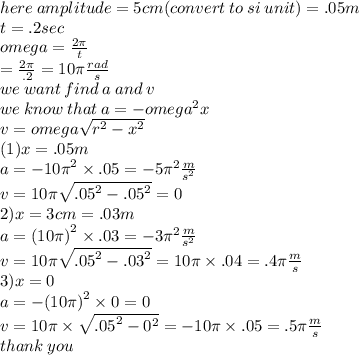
Physics, 03.09.2020 17:01, freddymoskali
 A body describes simple harmonic motion with an amplitude of 5 cm and a period of 0.2 s. Find the acceleration and velocity of the body when the displacement is (a) 5 cm, (b) 3 cm and (c) 0 cm.
A body describes simple harmonic motion with an amplitude of 5 cm and a period of 0.2 s. Find the acceleration and velocity of the body when the displacement is (a) 5 cm, (b) 3 cm and (c) 0 cm.

Answers: 3
Other questions on the subject: Physics

Physics, 22.06.2019 11:20, leandrogarin37p2g5ds
Suppose a diode consists of a cylindrical cathode with a radius of 6.200×10^−2 cm , mounted coaxially within a cylindrical anode with a radius of 0.5580 cm . the potential difference between the anode and cathode is 260 v . an electron leaves the surface of the cathode with zero initial speed (v initial=0). find its speed vfinal when it strikes the anode.
Answers: 1


Physics, 23.06.2019 01:30, kyrajewell2016
Aball is thrown vertically upwards from the top of a tower with a speed of 100m/s. it strikes the pound near the base of the tower after 25sec . the height of the tower is
Answers: 3

Physics, 23.06.2019 02:40, jarteria0
Check the following equation for dimensional homogeneity: ⅆ mv=∫t1t2(fcosθ)ⅆt where m is mass, v is velocity, f is force, θ is an angle, and t is time. check that each term in the equation has the following dimensions: [malbec] where you are to choose the coefficients a, b, c.
Answers: 2
Do you know the correct answer?
A body describes simple harmonic motion with an amplitude of 5 cm and a period of 0.2 s. Find the...
Questions in other subjects:

Chemistry, 05.10.2020 15:01


History, 05.10.2020 15:01


Chemistry, 05.10.2020 15:01



History, 05.10.2020 15:01








